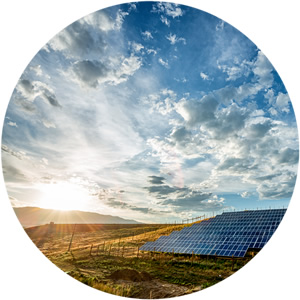
The flood risk and drainage assessment requirements for solar farms are uncertain. As they are often greater than one hectare, an assessment of flood risk is usually required throughout the UK and Ireland.
Flood risk must be considered from all sources: fluvial, pluvial, groundwater and, where relevant, coastal.
Most sites can avoid infrastructure in areas at higher risk of flooding, so infrastructure is generally located in areas with less than a 1 in 1,000 annual probability of river or sea flooding.
Any development greater than one hectare in size should include surface-water runoff management measures to greenfield run-off rates.
Do solar farms increase surface-water runoff?
Research into the impact of solar-farm panels on runoff rates and volumes indicates that solar panels do not have a significant impact on runoff volumes, peak rates or time to peak rates when the ground below the panels is vegetated.
Accounting for changes in soil type, slope angle and rainfall intensity, ground cover beneath solar arrays was found to have the most significant impact on runoff rates.
On this basis, if vegetation cover beneath the solar arrays is maintained, no significant increase in surface-water runoff is anticipated compared to greenfield runoff rates.
What should be done to minimise any effects?
- Minimise vegetation disturbance during construction.
- Re-vegetate as soon as possible to establish and maintain good ground cover across the site.
- Conduct regular inspections and maintenance of the site to ensure that vegetation cover is adequate and no rivulets are generated.
- Fence the site if needed, to avoid disturbance from livestock and ensure that vegetation can be maintained on the site.
Do solar farms require formal sustainable drainage?
Local authorities require developers to demonstrate that developments would not have an adverse effect downstream.
The flood assessment should be appropriate for submission to accompany the planning application, and should include recommendations for the most appropriate measures to manage surface-water runoff.
On the basis of the research conducted, it is unlikely that significant SuDS attenuation features will be required to manage the impact of solar arrays on downstream hydrology.
However, we generally recommend that a swale feature is incorporated into site design to ensure runoff is intercepted and stored within the swales before entering downstream watercourses. This will satisfy local authority requirements during planning.
Swales should be designed in accordance with the CIRIA SuDS manual using the long-term storage equation specifically addressing the additional runoff caused by a development.
Drainage systems should also be designed for a range of storms up to and including the 1 in 100 year event (plus an allowance for climate change), to ensure there are no detrimental impacts of flooding at the site or to adjacent areas.
What can be done at sites in higher risk areas?
If panels are proposed in areas of higher flood risk, the depth of flooding should be predicted for those areas (eg. depth of surface-water flooding predicted during the 1 in 30 year flood event).
All electrical connectors and other items vulnerable to flood water should be located at a minimum level of the maximum flood depth plus a 0.3m freeboard above ground level to ensure that they are protected to the design flood event.
The last word
So far, WHS have assessed the hydrological environmental impacts and/or flood risk and drainage requirements for over 20 large-scale solar farms across the UK and Ireland.